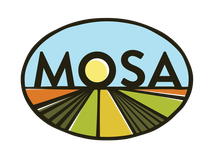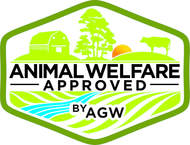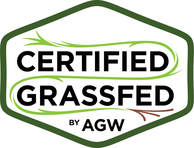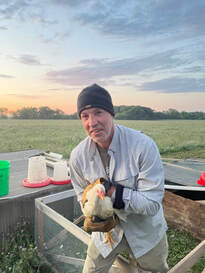 Well, it’s Fall and that’s a wrap on our pastured chicken season! Our newest venture on the farm, and something that customers have asked for years, this summer we finally felt established enough with the beef cows and pigs (and house construction/moving) to get it going. It was a lot of work and we had some learning curves, but it went very well and we are very happy with our product! Whenever we start a new venture we go back to “why” we are doing it, and to our mission statement and values to guide us on “how” to do it. There are many ways to raise chickens and many decisions to make in farming, but with our core values in mind:
we decided Certified Organic and Pastured was the way to go. So, what does that mean? and how exactly do we raise them? We get our chicks at one day old from a local Wisconsin hatchery and bring them straight to one of our small barns that was converted into the chicken brooder. Here the chicks grow under warming lights until they are old enough to regulate their own body temperature. Once they grow feathers, around 4 weeks, they can do so and are ready go outside! On pasture, they live in 2 chicken tractors that Paul and his cousin built (based on Joel Salatin’s designs book) and that are all around protected from predators. Paul moves the chicken tractors, manually, EVERY day- where they have fresh grass and bugs to eat, fresh air, and plenty of room to roam. We feed a certified organic poultry grain mix, also from a local, Wisconsin, organic mill. We put out fresh water daily with organic apple cider vinegar to help protect the chickens from bacteria or viruses. At around 8-10 weeks, we bring the chickens to get processed at a family owned, USDA organic processor, also here in Wisconsin. We pick them up 1-2 days later and at this point, they are ready to go to your homes! 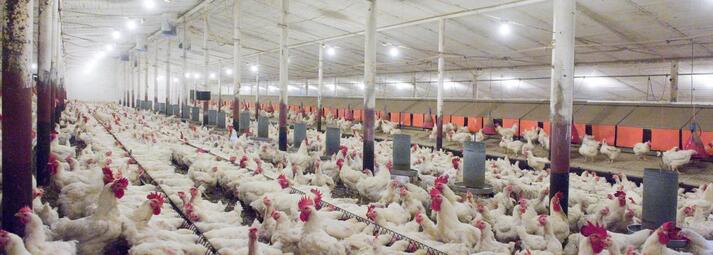 How does this compare to conventional, factory farmed chicken? Factory farm chickens are your good old, very inexpensive chicken at the supermarket. I’ve seen them for as low as $.99/lb, and a whole, already cooked, rotisserie chicken at Costco will cost you merely $5!! But what’s behind this incredible “deal”?
What about “Free Range Chickens”? Now, you might think this is better because they are “free to roam” but this is one of those labels that big ag probably negotiated with the USDA to approve for their marketing purposes. It means very little, but it sounds good. The requirement here is to “have access” to outside part time- but it is very loosely regulated and inspected. A free range bird could easily be one that spends most of its time inside a barn with hundreds or thousands of other bird friends—there may be a door to the outside, but there's no guarantee that your bird will ever venture out there, or that there's even much grass or soil to be found if it does. There is no requirement for these birds to spend ANY time outside; just to have “access”. and Certified Organic chicken? Let’s begin by stating the fact that most "organic chicken" in the supermarket is owned by two big producers, Tyson or Purdue. There are three requirements with organic that make them slightly better, sure:
However, the last one is where I see a bit of a problem. Conventional chickens require around 0.78 to 0.85 square feet per bird, while organic chicken requires 0.85 square feet per bird, which is really not that different! While access to the outdoors and fresh air is part of the organic standards for chickens, it is widely known that the USDA hasn’t really enforced this, and again, access to outdoors could be a concrete slab. It also doesn’t specify how much time they must be allowed to spend outside or how much space they should be given. Organic feed is another downside. It is well known that organic chicken feed at factory farms is many times imported from China. Our organic, pastured chickens also have significant health benefits when compared to conventional chickens. You have the obvious benefits of organic- NO antibiotics ever, NO pesticides, no herbicides or any kind of chemicals in their feed or our land. And NO GMO feed. But pasture-raised chicken also contains 50% more vitamin A compared to conventionally raised chicken. (This nutrient plays an important role in supporting good vision, cell division and growth, a strong immune system, and skin health.) Also, in a 2008 study published in the journal “Poultry Science”, Portuguese researchers discovered that pasture-raised chicken have significantly higher amounts of omega-3 fatty acids than chickens that do not have access to fresh forage. Lastly, while standard poultry feed is supplemented with small amounts of vitamin E, it doesn't come close to the bounty of vitamin E that chickens get from fresh pasture. And this vitamin E gets passed on to you, the consumer! And as we mentioned earlier, you are also at a much lower risk of contracting foodborne illnesses with our pastured poultry than with factory farmed chicken. Besides the health and animal welfare differences between factory farm and pastured chickens, the environmental differences are HUGE, and something that should be considered by all. Factory farms or CAFOs are known for the large amounts of toxic byproducts they generate, which are dumped or leach into the local ecosystem. One company, Tyson Foods Inc., released 104.4 million pounds of pollutants into waterways between 2010 and 2014. In contrast, our pastured chickens, improve our soil by fertilizing our land with their manure deposits. The bedding from our brooding barn goes directly into compost, also used as a natural fertilizer for our land. By supporting organic, pasture-raised poultry, you can help reduce pollution that is currently devastating the environment. Support Local When you buy our chickens, you are not only supporting a healthier and more humane treatment of these animals, you are also supporting your local economy through our family farm, a local hatchery, a local feed mill, and a local processor. I hope this post helps shed some light on how we raise our chickens, how it compares to others, and why we do what we do. And as always, please let us know your feedback, questions, or comments- we love to hear from you!
3 Comments
Last week we went to Central High School in Kenosha County to present to a Freshmen AP Geography class about Sustainable, Organic, and Regenerative Agriculture. It was super fun for Paul and I to talk to kids, who are the future of this country, about what is possible with Regenerative Ag. Something that is catching on in mainstream as a better, healthier way to farm for the environment and for our health.
After introducing ourselves and talking about who we are and what we do, we gave a background about the history of modern/industrial agriculture. Starting with "Old MacDonald", who use to do everything and integrated plants, crops, and a variety of animals, to industrialization bringing machinery, pesticides and fertilizers, specialization and "getting bigger" for efficiency. These were all things that were welcome by overworked farmers and actually did improve the lives and work of farmers at the time. However, nobody was able to foresee the consequences of these. Today, we know what these are- for our health and for the environment. Read about these in slides #16-#17. We then talked about what Organic farming, Animal Welfare, and additional certifications we pursued, given that organic standards have gotten relaxed (especially when it comes to animal welfare) once Big Ag got into it. Lastly, we talked about Regenerative Agriculture as a system of principles and practices that is not only "sustainable" but actually increases biodiversity, enriches soils, improves watersheds, and enhances ecosystem services. We talked about the importance of SOIL health. It ALL starts with healthy soil, something I found interesting and contrasting coming from a nutrition world when Hippocrates said "all disease begins in the gut". in human health, we have discovered most disease starts with an unhealthy gut. Similarly, we are now realizing, a healthy environment, and healthy food, starts with healthy soil. We explained the differences of grass fed vs. grain fed cows for beef and dairy. There are numerous health benefits of grass fed beef vs. grain fed, which includes less saturated and overall fat and more of the good fats like Omega 3s and CLA's in grass fed beef and dairy. We touched on the economics of farming, a sad reality of our broken food system that pays more for cheap, processed, and industrialized food than it does for "real food". It is more profitable for many farmers to grow commodity crops like soy and corn, sell them to the market where they get processed into your packaged food, and sold for very cheap at the store- than it is to grow healthier vegetables or pastured animals. Lastly, we provided a number of resources of local and some national organizations that have a wealth of information on these topics, and also some interesting books and documentaries we thought the kids (or anybody!) might like. At the end, we took in questions... with many very thoughtful and interesting questions coming from the kids. We welcome questions from you too! Please leave a comment, emil us, or contact us if you have any questions about anything you read in the presentation, what we do, or anything you'd like to ask us! We are happy to answer as best we can! Thanks for reading, and stay tuned for some more "educational" posts coming in the next few months. 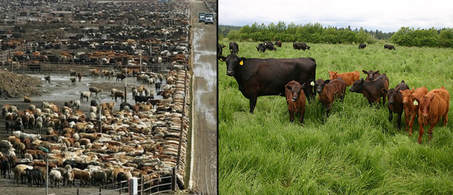 Beef factory farm vs. Regenerative agriculture beef farm Beef factory farm vs. Regenerative agriculture beef farm What motivates you to want to improve our environment? (i.e.… to recycle, compost, and use resources responsibly?) For us, our children do. Almost daily you can find an article or news story about climate change, and the misuse of natural resources and energy. A lot is blamed on agriculture pollution, and understandably so. 95% of agriculture in the US is conventional- using GMO seeds, herbicides, pesticides, chemical fertilizers, antibiotics, tillage, and heavy machinery. Many are factory farms, forcing the small farmer to make tough decisions to make a living. Farming income is the lowest it has been in 12 years. Small farmers have always been stewards of the land, but today, many are going from being practical to panic mode- cutting corners that make the land suffer. It’s the age-old fight between ecology and economy. I won’t keep writing about this because it can get quite depressing and I do believe ecology and economy can go hand in hand. There is an optimistic view! Regenerative agriculture is a “new type” of farming that has been gaining ground. It has soil health as the foundation for healthy land, ecosystem, and environment, while producing the healthiest and best quality food system. It consists of soils being covered with plants at all times during the year and building organic matter (adding carbon into our soils) as paramount to a healthy ecosystem. We began learning and practicing RE when we bought our farm in 2012. At our farm, we have a diverse amount of plant types populating our fields. The perennial plants capture water from rain to prevent runoff. These plants capture the sun's rays and turn this energy into food through photosynthesis. The plant takes in carbon dioxide and release oxygen. The land provides a wonderful habitat for pollinators. There is wildlife below the ground too, as millions of microbes, earthworms, and insects breakdown and recycle minerals and dead growth. Let the animals above and below the soils contribute to the interworking of our natural ecosystem! Our cattle are integral to this ecosystem process. They harvest these perennial plants and turn the plants into meat and milk. By plant harvesting, carbon gets deposited into the ground through root system death and regrowth. Without the cows harvesting the plant life, this ecosystem would become out of balance, and certain species would dominate. The cows also deposit fertilizer for the ecosystem to take in and recycle. All this is the ecology part. However, without the economy part, the ecology suffers. For small farmers to be able to make a living in our “big business-factory farming world”, we as consumers need to provide support to this movement. We can encourage this type of production and environmental protection with the spending of our food dollars. Grocery stores, restaurants, chefs, school cafeterias, and people cooking at home are what drive the food economy. We can make a difference to our health, our environment, and our children’s future with how we spend our food money. I once read “don’t ask why food is expensive, ask why food is so cheap” and it is so true. Keep in mind “cheap food” has a tremendous cost to our environment and our health. We might not consider this when spending our money on food but you are paying for it through your health care costs and your taxes. With economy and ecology working together you have the power to better our environment, provide stability to farmers and rural communities, and improve your health! Earth day has come and gone… But don’t we owe it to ourselves to think about this more than one day a year? What if every day we look at the way we use resources, the food we eat, the energy we use, the waste we produce that goes into landfills... a little bit can make a HUGE difference! |
AuthorMarisa usually writes about nutrition, grass fed beef, organic agriculture, as well as sharing delicious recipes; Paul writes about farm work- sharing his stories and experiences, and most times... we both collaborate on the stories! Archives
March 2024
Categories
All
|
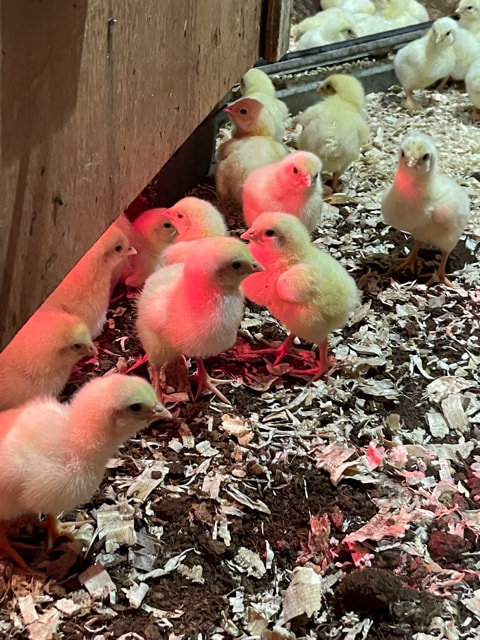
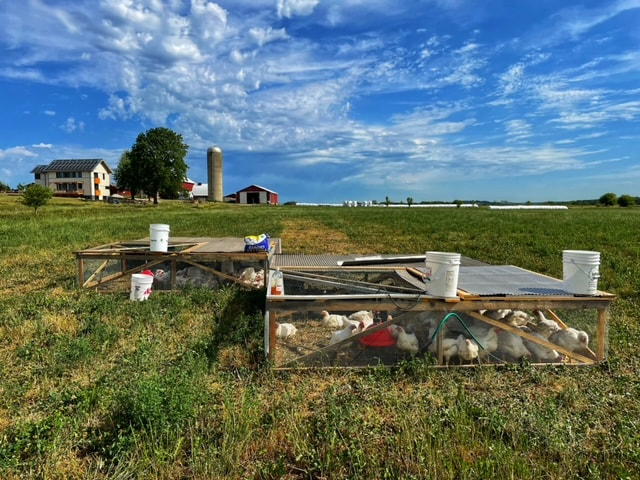
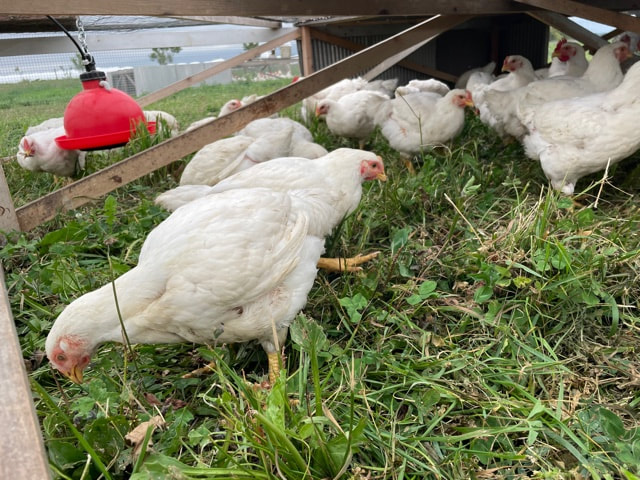
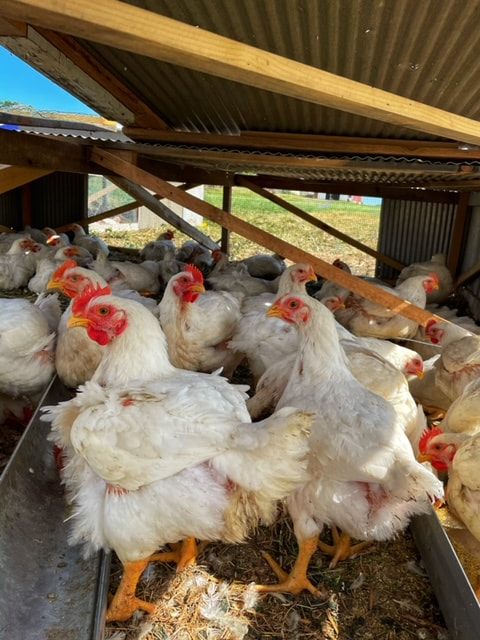
 RSS Feed
RSS Feed
